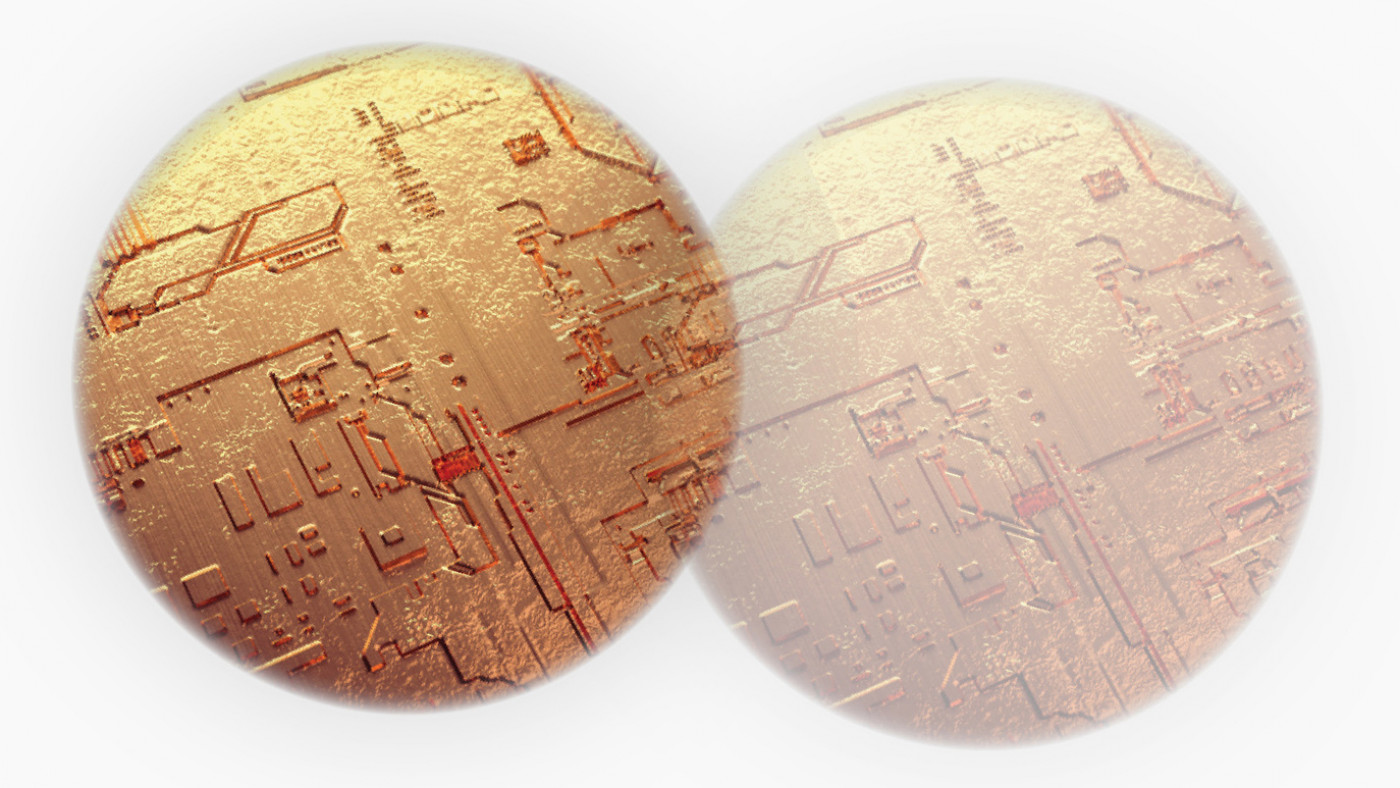The concept of a digital twin
The concept of a digital twin is nothing else as a virtual representation or mirror image of a physical object, system, or process. It is a digital counterpart that mimics the real-world entity in terms of its characteristics, behavior and interactions. The digital twin concept combines various technologies such as the Internet of Things (IoT), artificial intelligence (AI), data analytics, and modeling and simulation techniques (Fig. 1).
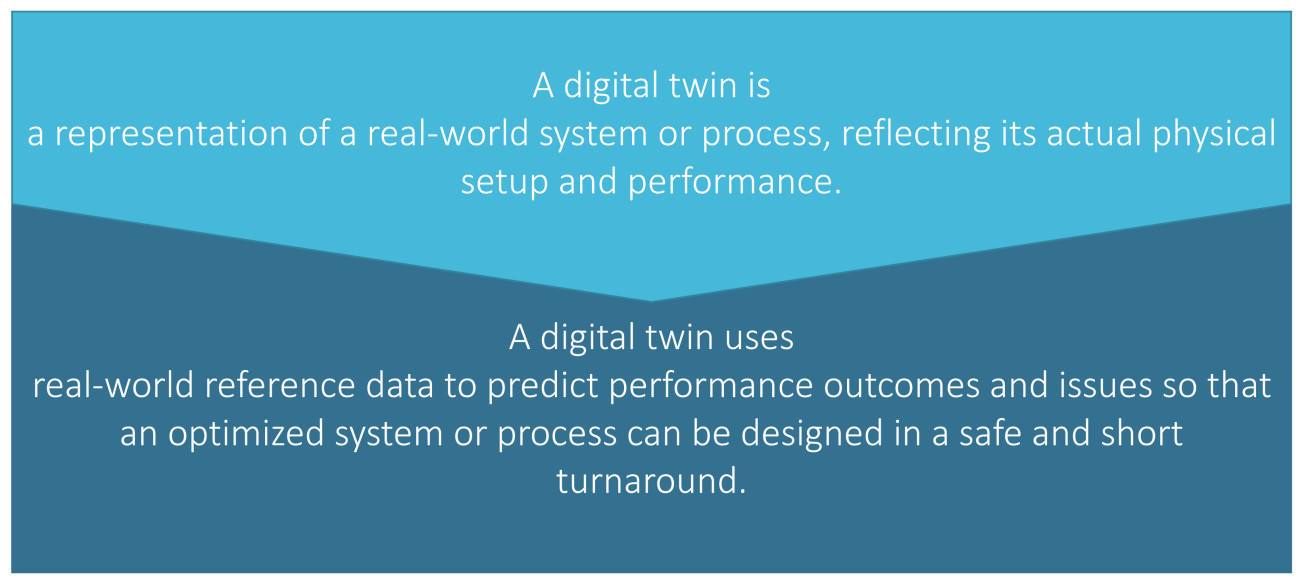 Fig. 1: Digital twin concept definitionDigital twins are typically created by collecting and integrating data from sensors, devices and other sources associated with the physical counterpart. This data is used to create a virtual model that replicates the physical object or system, allowing for real-time monitoring, analysis, and optimization. The digital twin can provide insights into the performance, condition and behavior of the physical entity, enabling better decision-making, predictive maintenance and performance optimization that can be designed in a safe and short turnaround. The concept of digital twins finds applications in various domains, including manufacturing, energy systems, healthcare, transportation, and urban planning. For instance, in PCB manufacturing, a digital twin can be used to analyze and optimize the Cu electroplating process step by, first of all, recognizing the actual process performance and then, by designing the most optimal mitigation strategy for the performance optimization.
Fig. 1: Digital twin concept definitionDigital twins are typically created by collecting and integrating data from sensors, devices and other sources associated with the physical counterpart. This data is used to create a virtual model that replicates the physical object or system, allowing for real-time monitoring, analysis, and optimization. The digital twin can provide insights into the performance, condition and behavior of the physical entity, enabling better decision-making, predictive maintenance and performance optimization that can be designed in a safe and short turnaround. The concept of digital twins finds applications in various domains, including manufacturing, energy systems, healthcare, transportation, and urban planning. For instance, in PCB manufacturing, a digital twin can be used to analyze and optimize the Cu electroplating process step by, first of all, recognizing the actual process performance and then, by designing the most optimal mitigation strategy for the performance optimization.
The concept of a digital twin plays a significant role in Industry 4.0 and Smart Manufacturing, which refers to the use of advanced digital technologies to create intelligent, connected and data-driven manufacturing systems (Fig. 2).
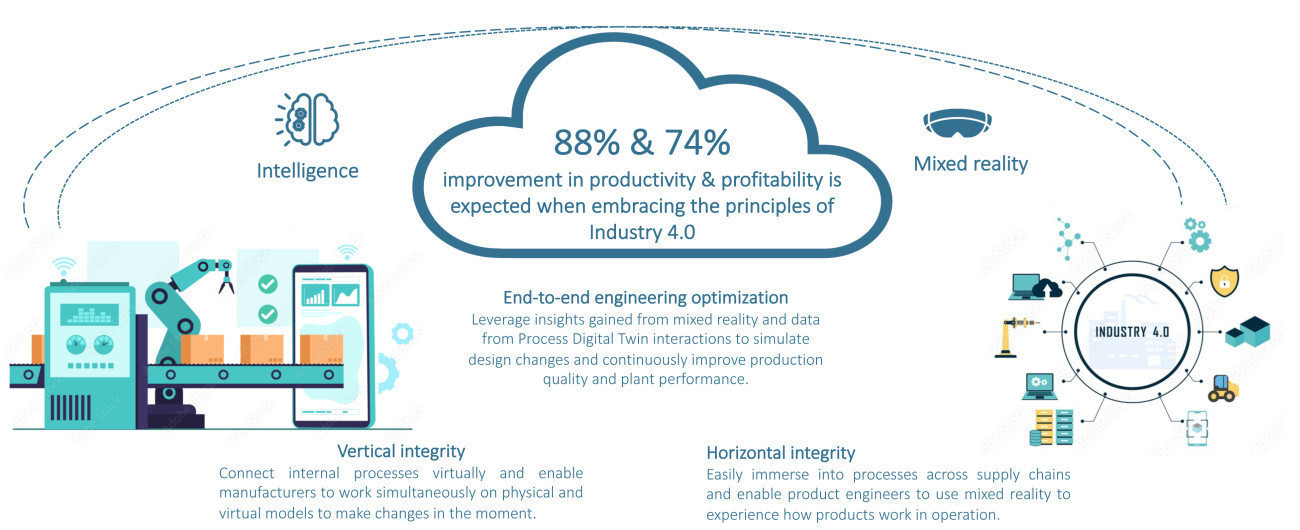 Fig. 2: Industry 4.0 conceptSome key roles of digital twins in Smart Manufacturing concept are:
Fig. 2: Industry 4.0 conceptSome key roles of digital twins in Smart Manufacturing concept are:
- Design and Development - digital twins enable manufacturers to create virtual prototypes of products and production systems - by simulating and analyzing various design options, companies can optimize product performance, reduce development time, and minimize costs before physical production begins.
- Predictive Maintenance - digital twins help in implementing predictive maintenance strategies by analyzing the condition and performance of products and production system based on the technical data, and identify early signs of potential failures. This enables proactive maintenance planning, minimizing downtime, reducing maintenance costs, and improving overall equipment effectiveness.
- Optimization and Simulation - digital twins provide a platform for simulating and optimizing manufacturing processes - by creating virtual replicas of production lines, the digital twin allows manufacturers to experiment with different scenarios, optimize workflows, and identify opportunities for efficiency improvements. This includes optimizing production schedules, minimizing energy consumption, and reducing material waste.
- Product Quality - digital twins can monitor product quality throughout the manufacturing process - by integrating data from sensors and quality control systems, the digital twin can indicate deviations, root causes of defects, and suggest corrective actions. This ensures consistent product quality and enables traceability by capturing data about materials, processes, and components used in the manufacturing process.
- Supply Chain Integration - digital twins facilitate the integration and coordination of the entire supply chain in smart manufacturing - by creating virtual representations of suppliers, logistics networks, and inventory systems, manufacturers can optimize material flow, inventory levels, and logistics planning. This helps in reducing lead times, improving agility, and enhancing overall supply chain performance.
- Continuous Improvement and Innovation - digital twins provide a feedback loop for continuous improvement and innovation - by collecting data on product performance, customer feedback, and market demands, manufacturers can analyze and identify areas for improvement. This includes optimizing designs, implementing product upgrades, and tailoring offerings to specific customer needs.
Overall, digital twins in smart manufacturing enable data-driven decision-making, enhance operational efficiency, improve product quality, and drive innovation. They provide a holistic view of the manufacturing ecosystem, allowing for optimization and continuous improvement across the entire value chain.
The concept of an electroplating process
The concept of electroplating refers to a process in which a metal coating is deposited onto a conductive surface through an electrochemical reaction. In the PCB plating, the initial plating step involves an electroless process wherein a chemical deposition of copper is applied to the surface areas of the board, including the interior of drilled holes. The purpose of this plating operation is to establish a thin metal layer on the board and within the holes, serving as the groundwork for the subsequent electroplating process. Afterward, the board undergoes preparation steps for electroplating process:
- contaminants and residues from drilling are removed from the holes,
- the interior of the holes is subjected to a micro-etching process to enhance the adhesion of copper,
- a photoresist material is applied to both the top and bottom surfaces of the board,
- the photoresist is selectively exposed to ultraviolet light, leaving only the desired metal circuitry patterns unprotected,
- the exposed and pliable photoresist covering the circuitry patterns is washed away, resulting in the remaining board surface areas being masked by the hardened photoresist (Fig. 3).
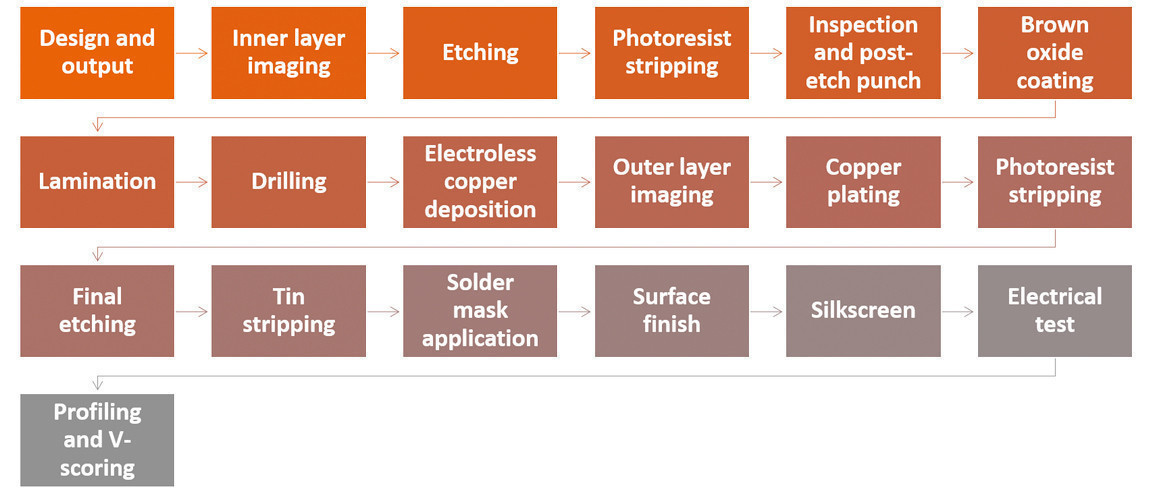 Fig. 3: PCB fabrication workflow with indication of the copper electroplating stepAt this stage, the board is prepared for the electroplating of copper onto its external layers and within the drilled holes. It is connected to the cathode, which carries the negative charge, of an electrical current and submerged in a chemical bath specifically designed for plating purposes. During the electroplating process, copper ions in the solution will migrate towards the negative charge, attaching to the exposed copper circuitry on the board (Fig. 4).
Fig. 3: PCB fabrication workflow with indication of the copper electroplating stepAt this stage, the board is prepared for the electroplating of copper onto its external layers and within the drilled holes. It is connected to the cathode, which carries the negative charge, of an electrical current and submerged in a chemical bath specifically designed for plating purposes. During the electroplating process, copper ions in the solution will migrate towards the negative charge, attaching to the exposed copper circuitry on the board (Fig. 4).
The process of copper electroplating serves dual purposes. Firstly, it enhances the thickness of the copper on the surface pads and conductors, thereby strengthening their integrity. Secondly, it establishes a reliable copper connection between layers by extending through the plated through-holes. With these, the quality of electroplated copper layer directly affects the board's performance, as well as its mechanical properties, and has certain influence on subsequent PCB fabrication steps. Hence, ensuring the quality control of copper electroplating process becomes a vital aspect of the PCB plating technique, often regarded as a challenging process even for experienced PCB manufacturing facilities. For instance, the fabricator must take into consideration that issues related to the copper electrodeposition process can jeopardize the integrity of interconnections within hole-walls, leading to potential failure of the PCB. Among the common deposition defects, the presence of plating voids in the copper lining the hole-wall is prevalent. Insufficient and incomplete coating of hole-walls can hinder the flow of electrical current. The occurrence of plating voids within plated through holes arises when the copper is not uniformly coated during the deposition process, hindering effective plating. Several factors contribute to this, including contamination, the presence of air bubbles along the hole's sides, and rough drilling. These factors collectively result in an uneven surface within the through hole, making it challenging to achieve a seamless and uninterrupted layer of copper. This challenge is particularly related to the PCB design as through-holes are an integrated part of the PCB design application, however, the electroplating process setup and lack of process control might bring further issues which consequences will be seen in uneven copper layer distribution. The challenges related to the process itself, compromise the physical parameters (Fig. 4) that need to be considered as well: type of plating bath and its electrochemical behaviour dependent on its: chemical composition and concentration, temperature, agitation and current density; substrate type, plating tank size, anode type, anode-anode spacing, rectifier specifications. These already show how many variables one have to control in order to make sure the copper electroplating process is being operated in the most appropriate way, so that an even copper deposit along all active surface areas on the PCB board can be achieved. Thus, it seems reasonable and beneficial to use an approach which will allow predicting the electroplated copper metal layer distribution on a dedicated PCB design before the actual, physical process will be set. In this way, we will be able to recognize potential issues with uneven copper coverage and mitigate them upfront, ensuring a reproducible process with the highest coating quality possible. To do that, the concept of a digital twin can be used.
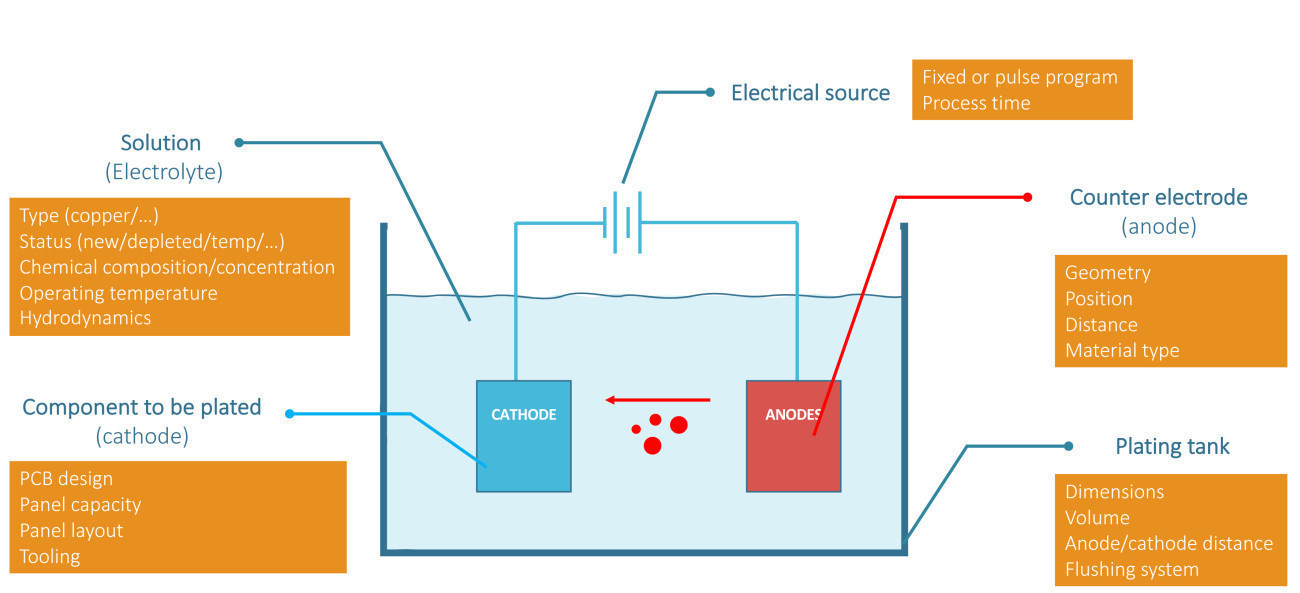 Fig. 4: Theoretical setup of an electroplating process with highlighted items that influence process performance.
Fig. 4: Theoretical setup of an electroplating process with highlighted items that influence process performance.
Copper electroplating process performance assessment through a digital twin concept
A copper electroplating digital twin is then a virtual representation of the physical copper electroplating process step as defined within the PCB fabrication workflow. It involves creating a digital model that mimics the physical infrastructure of the electroplating process setup, which compromises: plating bath information (and more specifically, an electrochemical behaviour of the copper plating solution represented by polarization data obtained at the stage of lab-scale deposition experiments), plating tank infrastructure information (tank dimensions, plating package, anode types, anode-anode spacing and anode-cathode spacing, etc.), process parameters (time of deposition, type of current program, etc.), and job data that is related to the specific PCB board and panel design (Fig. 5).
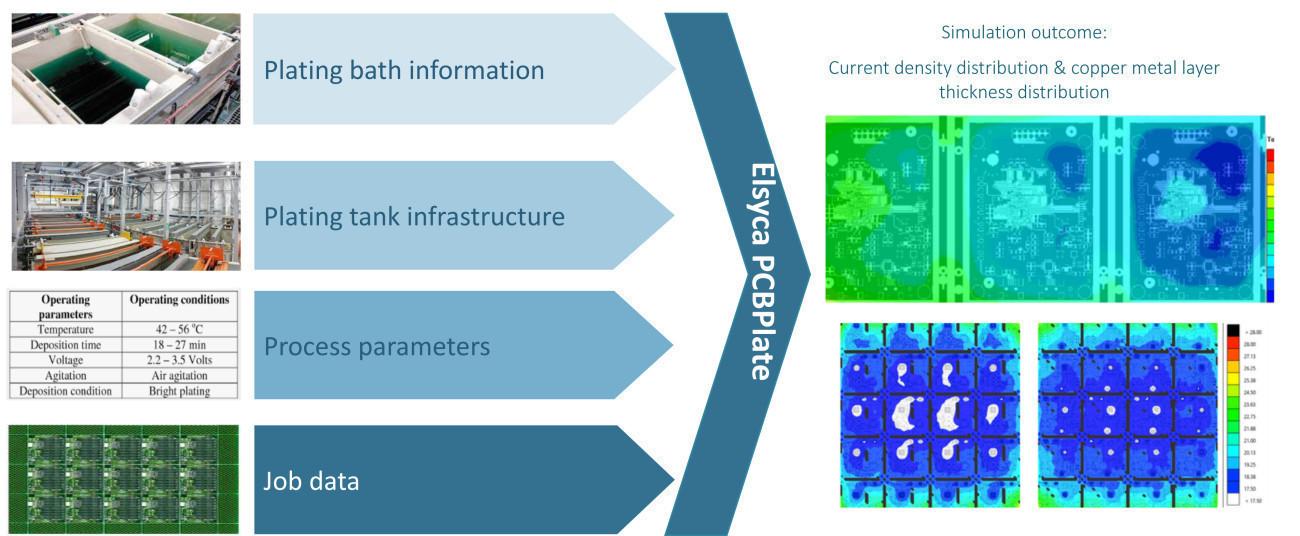 Fig. 5: Digital twin setup for predictive modelling of the electroplated copper metal layer distribution on a PCB board: left - digital twin input data, right - simulation outcome, colourful mapping indicates the differences in the copper layer thicknesses: red colour indicates overplated surface areas, while dark blue colour indicates underplated surface areas.With such information, a computational model is created and plateability analysis are run based on the technology that uses FEA (Finite Element Analysis) to solve the distribution of the current density and that calculates metal layer thickness values from Faraday's law. The outcome of such simulations one can expect is a clear overview of the current density distribution and copper metal layer distribution over all active surface areas on the PCB product. Thus, the approach enables for an upfront recognition of all copper over- and under-plated surface areas, based on the PCB product design and electroplating line setup, accounting for a Cu plating bath used. This in turn, gives a possibility to further optimize the process in order to achieve more homogenous copper layer distribution by further adjustment of the process parameters (deposition time, current density) and/or developing a dedicated mitigation strategy that will compromise the use of tooling components (shields, current robbers, dummy panels, auxiliary/conforming anodes; Fig. 6).
Fig. 5: Digital twin setup for predictive modelling of the electroplated copper metal layer distribution on a PCB board: left - digital twin input data, right - simulation outcome, colourful mapping indicates the differences in the copper layer thicknesses: red colour indicates overplated surface areas, while dark blue colour indicates underplated surface areas.With such information, a computational model is created and plateability analysis are run based on the technology that uses FEA (Finite Element Analysis) to solve the distribution of the current density and that calculates metal layer thickness values from Faraday's law. The outcome of such simulations one can expect is a clear overview of the current density distribution and copper metal layer distribution over all active surface areas on the PCB product. Thus, the approach enables for an upfront recognition of all copper over- and under-plated surface areas, based on the PCB product design and electroplating line setup, accounting for a Cu plating bath used. This in turn, gives a possibility to further optimize the process in order to achieve more homogenous copper layer distribution by further adjustment of the process parameters (deposition time, current density) and/or developing a dedicated mitigation strategy that will compromise the use of tooling components (shields, current robbers, dummy panels, auxiliary/conforming anodes; Fig. 6).
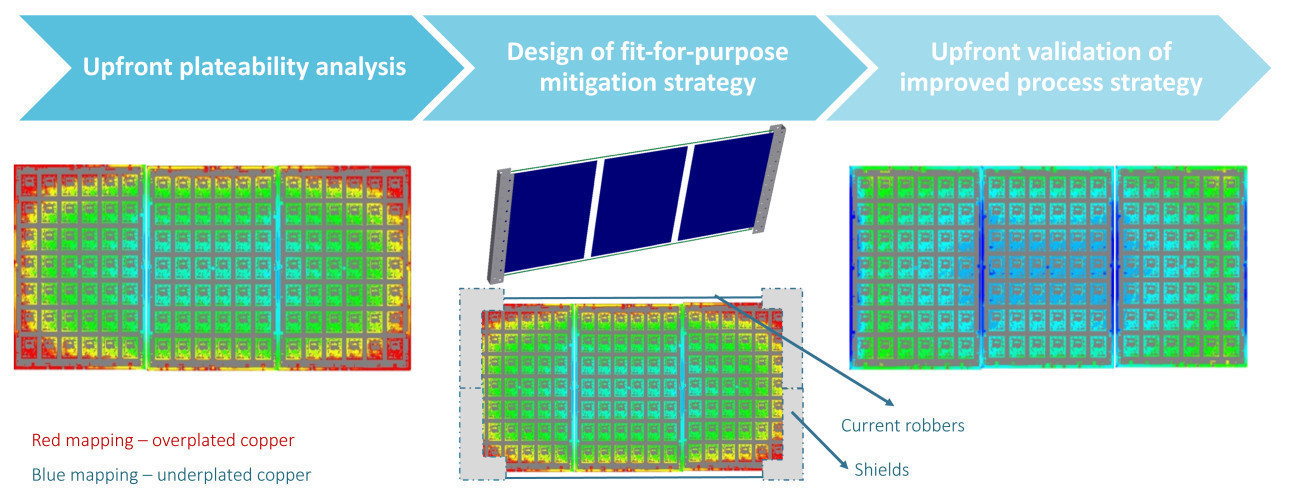 Fig. 6: Copper electroplating simulation workflow in the Elsyca PCBPlate software tool: upfront plateability analysis as baseline simulation to recognize the over and underplated surface areas, design of fit-for-purpose mitigation strategy - process optimization step, upfront validation of improved process strategy - evaluation of the actual process performance after sorting out the mitigation strategy.Since the process performance analysis, as well as process optimization, are both done in a computer environment, the approach of predictive modelling, or the approach of digital twin, gives enormous possibilities for better process design, analysis and optimization. It significantly reduces the wet process tests, providing savings of resources at any level, making sure the quality of the deposited copper layer is always as required and is no longer dependent on the process operator. One of the biggest advantages of using the electroplating digital twins is the ability to perform quick what-if analysis that can further explore different scenarios to verify the process potential for variety of the PCB products, from rather simple, up to the most complex ones, what gives the opportunity to accommodate more jobs with different products coming from other PCB OEMs.
Fig. 6: Copper electroplating simulation workflow in the Elsyca PCBPlate software tool: upfront plateability analysis as baseline simulation to recognize the over and underplated surface areas, design of fit-for-purpose mitigation strategy - process optimization step, upfront validation of improved process strategy - evaluation of the actual process performance after sorting out the mitigation strategy.Since the process performance analysis, as well as process optimization, are both done in a computer environment, the approach of predictive modelling, or the approach of digital twin, gives enormous possibilities for better process design, analysis and optimization. It significantly reduces the wet process tests, providing savings of resources at any level, making sure the quality of the deposited copper layer is always as required and is no longer dependent on the process operator. One of the biggest advantages of using the electroplating digital twins is the ability to perform quick what-if analysis that can further explore different scenarios to verify the process potential for variety of the PCB products, from rather simple, up to the most complex ones, what gives the opportunity to accommodate more jobs with different products coming from other PCB OEMs.
Proper copper balancing at a PCB design stage matters!
PCB fabrication, involving etching and plating processes, relies on copper traces for bringing the conductivity. By ensuring unform copper plating across each PCB layer, one creates consistent conductor thickness on the plated surfaces, improving signal transmission and overall circuit performance. The homogenous copper distribution over all active surface areas provides a better PCB thickness during lamination process, as well as reduces low-pressure areas that may call for re-design. An optimal copper coverage and unform distribution of copper thickness during plating can be achieved by assuring a proper copper balancing at a PCB design stage: copper balancing is one of the vital specifications to be followed when fabricating PCB products - this is a method of achieving a symmetric distribution of copper traces in every layer of the PCB stack-up in order to avoid electrical and mechanical (bow, twist, warp) issues that can impede the circuit performance. Considering the electroplating process, an imbalance of copper at the top and bottom surfaces, or within individual stack-up layers, can result in overplating, leading to undesired connections between traces, or underetching. Thus, copper balancing is important from several reasons:
- Current distribution - copper traces on a PCB carry electrical currents between different components. When the current flows through a trace, it encounters resistance, resulting in voltage drop. If the copper distribution is not balanced, some traces may carry more current than others, leading to uneven voltage drops. This can cause variations in the performance of components and can even result in circuit failure.
- Signal integrity - in high-speed digital circuits, signal integrity is crucial for proper data transmission. Copper imbalances can lead to impedance mismatch and signal reflections, causing signal distortion, data errors, and reduced system reliability. By ensuring copper balance, the impedance of signal traces can be controlled, minimizing signal degradation and improving overall system performance.
- Thermal management - copper traces act as conductors for heat dissipation in PCBs. If copper distribution is unbalanced, some areas may experience higher current densities and, consequently, generate more heat. This can lead to localized hotspots, affecting the reliability and performance of components. By properly balancing the copper, heat dissipation can be evenly distributed, preventing thermal issues.
- Manufacturability - if the copper distribution is uneven, it can affect the uniformity of etching and plating processes, leading to manufacturing difficulties and potential defects. By balancing the copper, the manufacturing process becomes more predictable and consistent, resulting in higher-quality PCBs.
However, in the majority of cases, the process of copper balancing in PCB design is often overlooked or carried out inadequately, which becomes evident when exploring user forums dedicated to PCB design. This situation arises because copper balancing is typically performed using standard PCB design software tools that offer built-in copper balancing options. However, relying solely on these built-in functionalities is not the most optimal solution. These tools provide limited flexibility in defining the shape of copper areas, often limited to selecting rectangular or polygonal objects from a predefined menu. Additionally, the copper balancing task needs to be performed manually, which makes the entire process time-consuming. Moreover, it should be noted that many instances of copper balancing operations performed within standard PCB design software tools fail due to incorrect specification settings and a lack of understanding regarding the copper balancing approach. In Figure 7, we can observe the consequences of inadequate copper balancing.
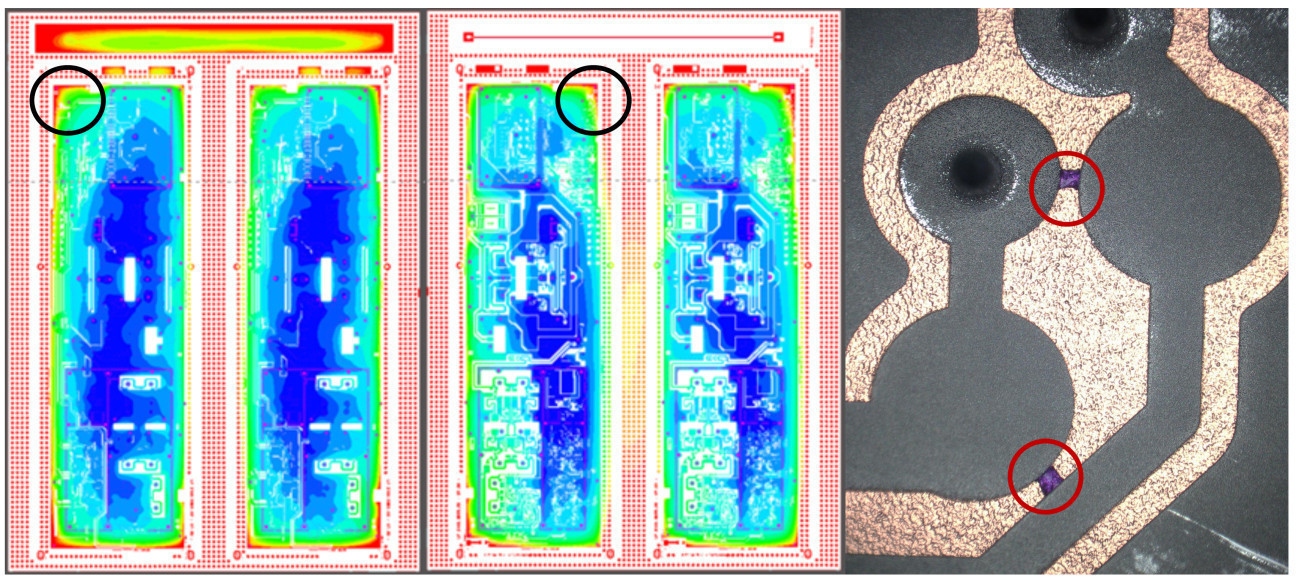 Fig. 7: Left & center – front & back side of a PCB design: improper copper balancing done within a standard PCB design tool, resulting in overplated copper (red surface areas indicated by black circles). Right - shorts (red circles) caused by photoresist residues still pinched after photoresist stripping in SES process.The left and center images depict overplated copper surface areas (indicated by red zones within black circles) on both sides of the PCB model (front and back). These overplated areas were a result of incorrect copper balancing during the PCB design stage. Consequently, shorts (depicted by red circles in the right image) appeared due to photoresist residues that remained trapped after the photoresist stripping process in the SES (Strip-Etch-Strip) procedure. These shorts had a notable impact on the performance of the PCB.
Fig. 7: Left & center – front & back side of a PCB design: improper copper balancing done within a standard PCB design tool, resulting in overplated copper (red surface areas indicated by black circles). Right - shorts (red circles) caused by photoresist residues still pinched after photoresist stripping in SES process.The left and center images depict overplated copper surface areas (indicated by red zones within black circles) on both sides of the PCB model (front and back). These overplated areas were a result of incorrect copper balancing during the PCB design stage. Consequently, shorts (depicted by red circles in the right image) appeared due to photoresist residues that remained trapped after the photoresist stripping process in the SES (Strip-Etch-Strip) procedure. These shorts had a notable impact on the performance of the PCB.
To prevent the aforementioned scenario, it is essential to adhere to established guidelines for proper copper balancing:
- To prevent the formation of copper nests, it is crucial to distribute conductor traces as evenly as possible throughout the entire board. This principle should be followed for each layer individually, as well as across any axis of symmetry between two or more layers.
- In cases where large areas are required, it is necessary to maintain copper balance by symmetrically filling the corresponding layers with copper in the areas opposite to the open spaces. This ensures that there is a counterbalance to the copper present in the opposing layer.
- Whenever feasible, large copper areas should be designed as a grid pattern. This grid structure helps prevent any bowing or twisting effects, particularly in single-layer circuit boards. Additionally, employing a grid pattern promotes better copper uniformity along the walls of plated through holes.
To achieve the aforementioned goals, a dedicated copper balancing tool, as shown in Figure 8, is utilized. This tool enables the PCB designer to optimize the copper balance by identifying critical areas on the board that may pose plating challenges during the fabrication process. By employing an automated approach, potential issues can be effectively mitigated. The copper balancing tool utilizes the Finite Element Method (FEM) to determine the optimal balancing fraction, which represents the copper density within each finite element in the balancing area. This process ensures an optimal copper distribution within seconds, with the outcome primarily dependent on the complexity of the PCB design rather than the PCB designer's manual intervention. Consequently, the tool allows for immediate one-to-one comparisons, facilitating efficient design adjustments and reducing the likelihood of requiring redesigns.
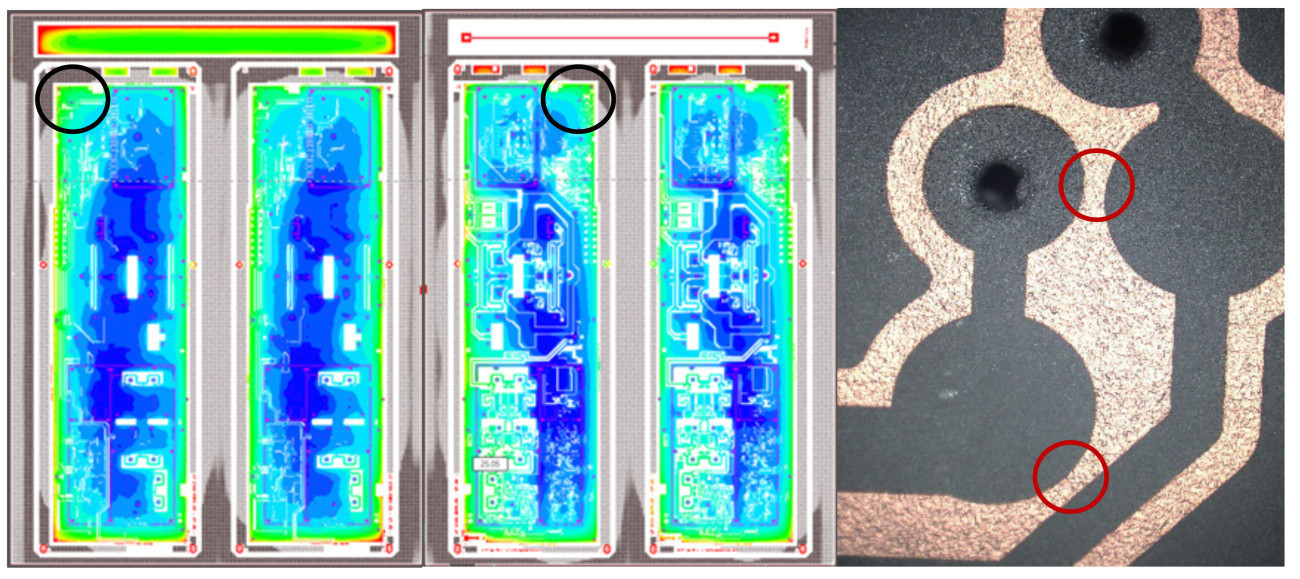 Fig. 8: Left & center – front & back side of a PCB design: proper copper balancing, resulting in an optimal copper thickness (black circles). Right - no copper shorts (red circles) are observed as the copper balancing has been done with a dedicated copper balancing Elsyca PCBBalance software tool.With the examples shown above, it is proven that copper balancing in PCB design ensures optimal current distribution, maintains signal integrity, promotes efficient thermal management, and enhances manufacturability. It contributes to the overall functionality, reliability, and performance of the PCB and the electronic system it is a part of. Furthermore, it has also been shown that proper copper balancing is a crucial step in achieving a target copper thickness during electroplating processing. A digital twin concept allows for the upfront analysis and optimization of the surface treatment processes, and definitely for an optimization of the copper electroplating process of the PCB products. By virtually testing different scenarios and variables, fabricators can identify the most efficient and cost-effective production parameters and mitigation strategies. This optimization improves product quality, reduces waste, shortens production cycles, and enhances overall productivity. Digital twins facilitate data analysis and performance evaluation. This data-driven approach supports continuous improvement initiatives and decision-making processes. This virtual representation enhances understanding, visibility, and control over manufacturing operations that result in long-term benefits.
Fig. 8: Left & center – front & back side of a PCB design: proper copper balancing, resulting in an optimal copper thickness (black circles). Right - no copper shorts (red circles) are observed as the copper balancing has been done with a dedicated copper balancing Elsyca PCBBalance software tool.With the examples shown above, it is proven that copper balancing in PCB design ensures optimal current distribution, maintains signal integrity, promotes efficient thermal management, and enhances manufacturability. It contributes to the overall functionality, reliability, and performance of the PCB and the electronic system it is a part of. Furthermore, it has also been shown that proper copper balancing is a crucial step in achieving a target copper thickness during electroplating processing. A digital twin concept allows for the upfront analysis and optimization of the surface treatment processes, and definitely for an optimization of the copper electroplating process of the PCB products. By virtually testing different scenarios and variables, fabricators can identify the most efficient and cost-effective production parameters and mitigation strategies. This optimization improves product quality, reduces waste, shortens production cycles, and enhances overall productivity. Digital twins facilitate data analysis and performance evaluation. This data-driven approach supports continuous improvement initiatives and decision-making processes. This virtual representation enhances understanding, visibility, and control over manufacturing operations that result in long-term benefits.

Author
Agnieszka Franczak, PhD, Head of Surface Finishing Division at Elsyca – a member of the Elsyca team: Elsyca develops dedicated software solutions for the electrochemical-based process analysis and optimization, and provides computer-aided engineering services for those, who face challenges with process design, control, quality, and reproducibility. A wider topic overview, as well as detailed insights to the predictive modelling solutions on an industrial scale can be gathered by getting in touch with the Elsyca team:
www.elsyca.com, Diese E-Mail-Adresse ist vor Spambots geschützt! Zur Anzeige muss JavaScript eingeschaltet sein!.
References
[1] Elsyca PCBPlate solution: www.elsyca.com/elsyca-solutions/elsyca-pcbplate
[2] Elsyca PCBBalance solution: www.elsyca.com/elsyca-solutions/elsyca-pcbbalance
[3] PCB Metal Balancing, Patent, WO 2021/191346 A1
[4] Introduction of a comprehensive structure model for the digital twin in manufacturing., T. Lechler, J. Fuchs, M. Sjarov, M. Brossog, A. Selmaier, F. Faltus, T. Donhauser, J. Franke,25th IEEE International Conference of Emerging Technologies and Factory Automation (ETFA), 2020.
[5] Three-dimensional simulations of current density distribution for patterned wafers and PCB's., G. Nelissen, B. Van den Bossche, I. Purcar, J. Deconinck, In IPC, 2004.
[6] Three-dimensional current density distribution simulations for a resistive patterned wafer., M. Purcar, B. Van den Bossche, L. Bortels, J. Deconinck, G. Nelissen, Journal of the Electrochemical Society, 2004.
[7] A performance simulaton tool for bipolar pulsed PCB plating. G. Nelissen, B. Van den Bossche, L. Wanten, In ECWC 10 Conference at IPC, 2005.
Image sources
Sierra Circuits: www.protoexpress.com/kb/pcb-manufacturing-overview/
Acknowledge
Special thanks to Sascha Reuter and Manuel Luschtinetz from Rohde & Schwarz, Germany, for providing reference materials related to copper balancing simulations and production outcomes (Images 7 & 8), as well as for an outstanding collaboration within the past months.

